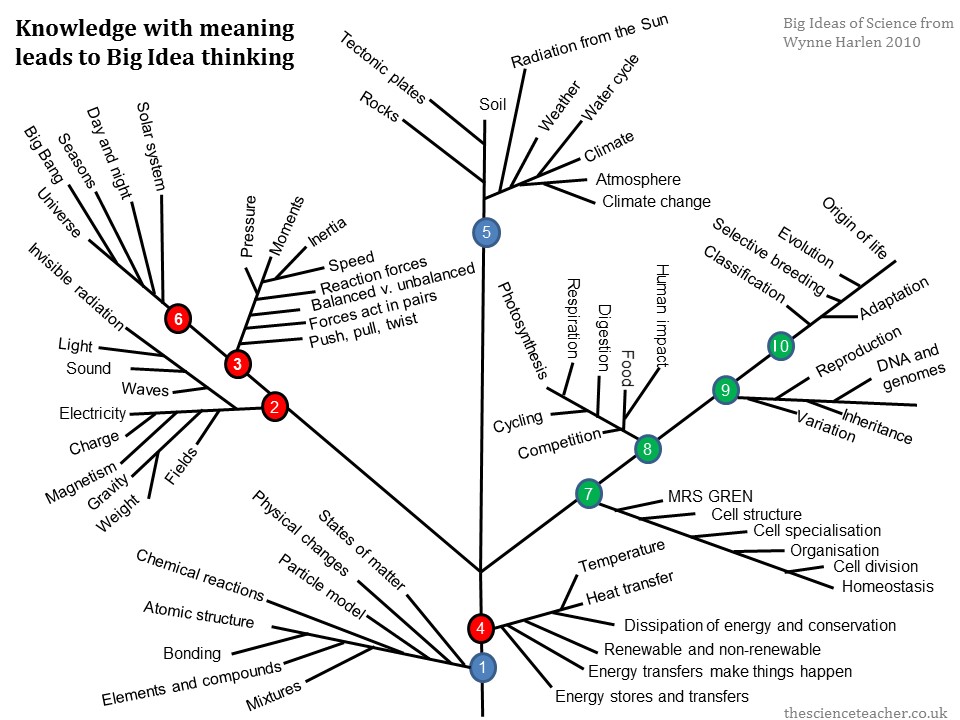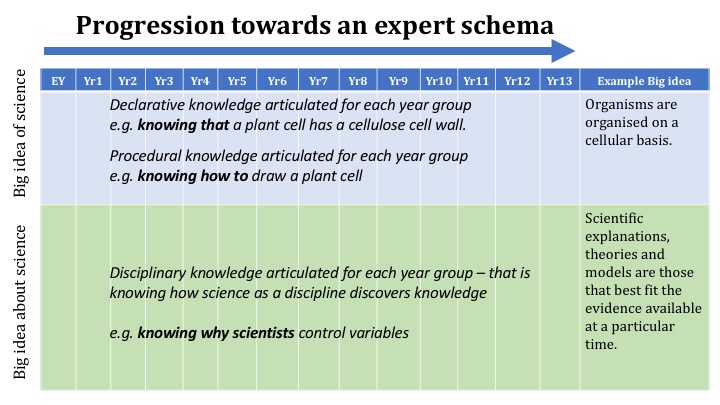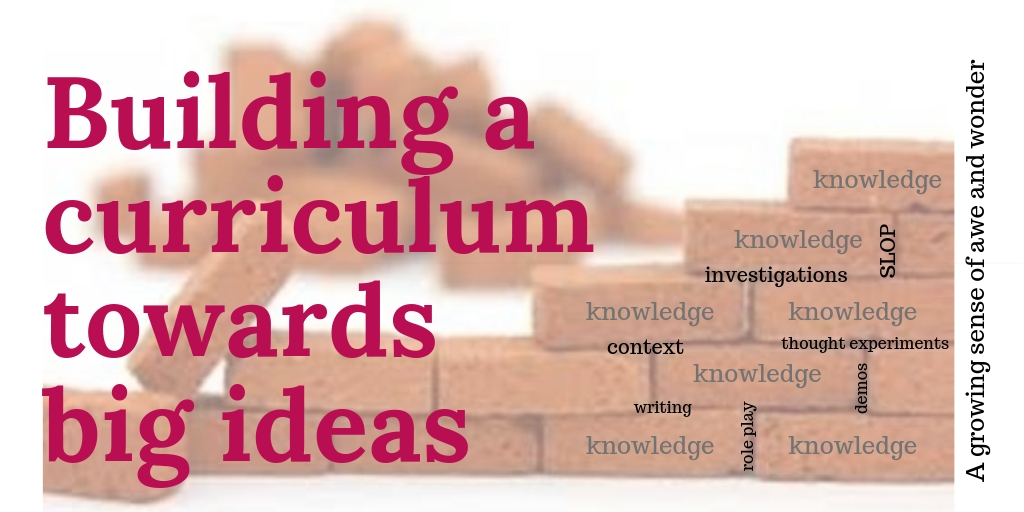Building a curriculum towards big ideas
This post is part of the “Curriculum in Science” symposium curated by Adam Boxer (@adamboxer1). Read Adam’s introduction here. Ruth’s post on “The Language of Curriculum” is here. e=mc2andallthat writes about misconceptions in the curriculum here.
Science education – for who and for what?
I couldn’t decide. Should I have the rabies vaccine or not? With any vaccine there’s the risk of entering a state of anaphylaxis, but I’m told this is less than 1 in 1 million. Then there’s the realisation that once symptoms show, rabies is an incurable and devastating disease. But unlike many jabs, a single inoculation won’t stop me from contracting the disease, it simply buys more time. 
What’s this got to do with the science curriculum?
Well, as I was weighing up my vaccination options, I got distracted thinking about something else. Why do animals infected with rabies go mad? How does a virus cause madness and do infected humans froth at the mouth too? After a quick google it seems they do and worse still, the virus stops the patient from swallowing – this really is a terrible disease. Making connections between these new ideas and what I already knew about evolution, viruses and cells was satisfying and gave me an entirely new appreciation of the damage a tiny piece of nucleic acid can do.
So whilst it’s commonly claimed the aims of science education are for economic advantage, or to prepare citizens to make decisions, I’m not so convinced. Less than 20% of students will become scientists and I’m unsure whether school science can really equip students with the necessary understanding to make informed decisions on issues such as vaccination and global warming. Medical students smoke, ecologists board planes and chemists sunbathe. Experts then, and not distant memories of school biology, are probably best placed to guide our decision making. Instead, the science curriculum needs a more universal and ambitious aim – that is to teach a set of core ideas that will enable all students to experience a personal sense of awe and wonder when describing and explaining the natural world.
Science education for its explanatory power
But what should these ideas be? Back in October 2009 a small group of scientists, engineers and science educators met in Scotland to identify a series of big ideas that can explain the world (Harlen, W., 2010). It is these big ideas that are relevant to all students and can help educators to conceptualise and structure the science curriculum.
What are big ideas?
Big ideas are statements that attempt to describe some major understanding that students need to develop. These understandings act as metaphorical ‘lenses’ by which students can make sense of a whole host of problems. In some ways each big idea is analogous to a giant schema – a hypothetical mental framework that experts have where smaller, related ideas are linked together and stored in long term memory. Ten big ideas of science education were identified in total, along with four big ideas about science. You can read further about these big ideas here and links to original publications on the ASE website are at the bottom of this page. Some examples of big ideas are below:
- All matter in the Universe is made of very small particles
- Objects can affect other objects at a distance
- Organisms are organised on a cellular basis and have a finite life span
What’s important is that these big ideas and the understanding that sits beneath them are equally relevant to students who want to go on and work in science as it is for those who want to live with an appreciation of science. For me this is crucial – there is something incredibly unifying and equitable about big ideas.
What big ideas are not
Whilst big ideas help to frame the ultimate goals of science education, it’s important to recognise that big ideas cannot be taught directly. This sounds a bit odd, but just as we can’t teach students to be ‘problem solvers’, we can teach them a body of knowledge that enables them to solve problems in a specific domain.
If we try to devise activities that teach big ideas directly, we end up with some superficial activity. Perhaps a trivial example, but completing the gap fill below will not arrive at big idea thinking – that is that all matter in the Universe is made of very small particles.
All m________ in the U________ is made of very _________ ____________.
But neither will diffuse descriptors of big ideas help students think big. Asking students to know and understand that ‘the behaviour and arrangement of atoms explains the properties of different materials’ is unhelpful. Statements like these define the goal, but they don’t help us with knowing how to get there. What arrangement and which properties are we explaining? Instead, big idea thinking requires us to first define and sequence the knowledge that sits beneath each big idea. You can see an attempt to represent this in the tree diagram I’ve made. Here an understanding of big idea one develops from knowing many different concepts (state changes, mixtures, bonding etc). What I didn’t draw (but should have) is the many leaves that sit at the tips of each branch – and it is these leaves, or bits of knowledge, that need to be articulated too when designing the curriculum.
You can see an attempt to represent this in the tree diagram I’ve made. Here an understanding of big idea one develops from knowing many different concepts (state changes, mixtures, bonding etc). What I didn’t draw (but should have) is the many leaves that sit at the tips of each branch – and it is these leaves, or bits of knowledge, that need to be articulated too when designing the curriculum.
Connecting the dots
But lists of knowledge are not sufficient to generate big idea thinking. What’s just as important is that this knowledge is linked together in students’ minds as it is this linking, or construction, that creates understanding. This linking takes time, and requires students to engage in practice and a degree of struggle to promote reorganisation of ideas that will ultimately lead to a personal understanding. To create time for struggle we need to select the most important knowledge for our curriculum- that is the knowledge that has a function in helping subsequent learning and so facilitates progression towards the big ideas.
Knowing then that particles are arranged differently in solids, liquids and gases is important, but only becomes meaningful knowledge when it is integrated into a wider framework that includes both formal knowledge (particles randomly moving in gases) and informal knowledge (smelling the chip shop from across the road). The ultimate goal though is not just to use big ideas to explain phenomena such as salt dissolving or carbon combusting, big ideas should enable students to experience a sense of awe and wonder when they interact with the natural world. So just as watching a film can stir emotion, the realisations below should also move us.
- Everyday our bodies fight against entropy and one day we will lose this fight and our atoms will be set free. So death is not the end, it’s the beginning.
- A bullet fired from a gun and a bullet dropped from the same height will hit the ground at the same time. Physics is mind blowing!
- When you eat a mushroom, you are eating quite a close relative. Vegetarians watch out.
- Dissolving salt breaks the same ionic bonds as melting salt, but during dissolving, water ‘pays the price’.
Big ideas help to organise
The real genius though of big ideas is not only do they help to define the ultimate goal of the curriculum, and so help select what knowledge should and should not be included, they also provide a framework or narrative to help us organise this knowledge. And this framework directly supports what we know about how students learn science e.g. grouping related ideas together, moving from concrete to abstract ideas and revisiting and building upon the same idea multiple times in a spiral fashion.
 Because the same big ideas can be used from Early Years all the way to age 18 (or beyond), we can easily chart the progression of related knowledge across different key stages. A very rough representation of what this could look like is shown – using this approach you can create coherence throughout the curriculum and it enables teachers and students to easily see how what they are learning now relates to what comes next and what came before. The learning journey now has a map we can follow, and we can use this map to sequence both the declarative and procedural knowledge (ideas of science) as well as the disciplinary knowledge (ideas about science) whilst taking account of the interactions that occur between all these different types of knowledge. For example, atomic structure is a helpful context to teach students about why scientists use models and so these ideas should probably be taught together.
Because the same big ideas can be used from Early Years all the way to age 18 (or beyond), we can easily chart the progression of related knowledge across different key stages. A very rough representation of what this could look like is shown – using this approach you can create coherence throughout the curriculum and it enables teachers and students to easily see how what they are learning now relates to what comes next and what came before. The learning journey now has a map we can follow, and we can use this map to sequence both the declarative and procedural knowledge (ideas of science) as well as the disciplinary knowledge (ideas about science) whilst taking account of the interactions that occur between all these different types of knowledge. For example, atomic structure is a helpful context to teach students about why scientists use models and so these ideas should probably be taught together.
Are these really THE big ideas?
Put a different group of science educators together and I have no doubt they will generate a different set of big ideas to those of Harlen et al. Whilst we should strive to identify the most powerful big ideas as a science community, we also need to be pragmatic and choose those ideas that best help structure knowledge within the programmes of study we are teaching. You may therefore choose to split big idea 1 into smaller sub ideas, such as ‘how particles are arranged in materials affects their properties’ and ‘all matter is made from particles’. What’s most important is not what the big ideas are, but that the same ones are used throughout a child’s schooling to enable curriculum coherence so students can move from year to year and class to class and still be part of one curriculum.
 What do big ideas look like in the classroom?
What do big ideas look like in the classroom?
The danger with any curriculum is that the principles involved in developing it quickly disappear or get corrupted by the time they reach the classroom. We continue to teach cells, forces, particles etc. as we always have, just that this time these topics are arranged differently on some curriculum map. However, for a curriculum to have a transformative effect on learning it needs to live and breathe in the classroom, informing both the pedagogy and assessment that sits beneath it.
I hope some of the ideas below go someway to keep the big ideas in the curriculum alive.
- Spend time with colleagues engaging with the big ideas and adapt them for your school. What’s most important is that the same big ideas are used by all teachers within a school and that there is a sense among teachers that these are the right ones.
- Work as a department to define and sequence the knowledge that sits beneath each big idea using key questions, and scripting expected answers you hope students will learn. The current programmes of study and published resources are a great starting point.
- Attribute each unit to a big idea. At the start of a new unit activate prior knowledge from previous units from within the same big idea – you could create spider diagrams, MCQs or concept maps. The purpose is for students to recognise the expansion of their own schema.
- Within a unit, quiz knowledge from other units that belong to the same big idea – this will encourage students to see relationships between related ideas whilst also helping memory.
- Set cumulative assessments that require students to use all their knowledge from one big idea.
- Create time in the curriculum for students to see and experience the explanatory power of the big idea through practical demonstrations, writing, cognitive conflict, reading, practical work, socio-scientific problems and inquiry
A final note
I hope I have convinced you of the power of a curriculum structured around big ideas. In many ways the simplicity of this framework is what makes it so powerful – ten big ideas of science in total and four big ideas about science. Not only do big ideas provide a goal for science education that is relevant to all students, they also help to organise the curriculum in a way that informs the pedagogy and assessments that sit beneath them. For me, this organisation reflects how we learn science – assembling small ideas together to create powerful mental frameworks that explain and help us appreciate lots of wonderful things.
Further reading
- Mitchell, I., Keast, S., Panizzon, D., & Mitchell, J. (2017). Using ‘big ideas’ to enhance teaching and student learning. Teachers and Teaching, 23(5), 596-610.
- Harlen, W. (Ed.) (2015). Working with big ideas of science education. Association for Science Education.
- Harlen, W. (Ed.) (2010). Principles and big ideas of science education. Association for Science Education.

